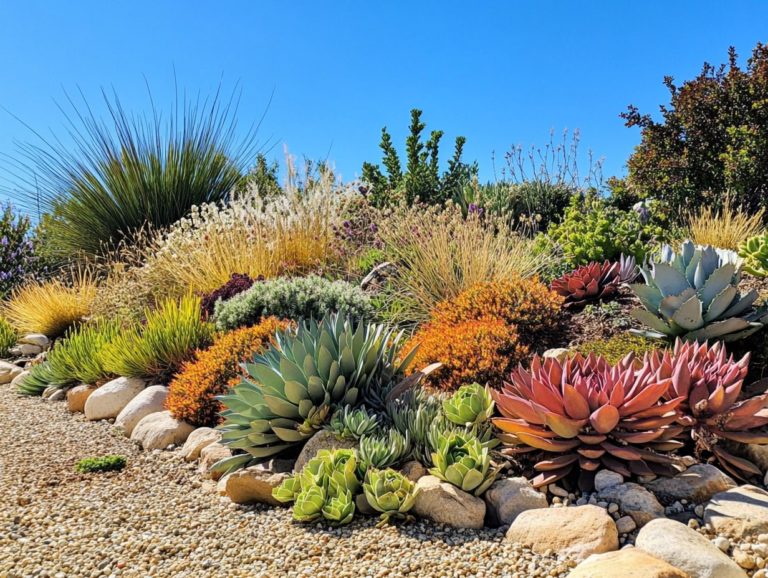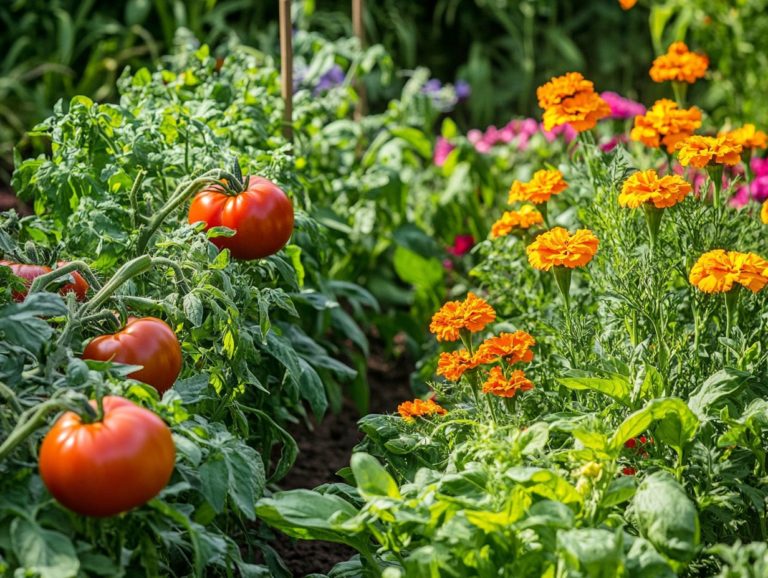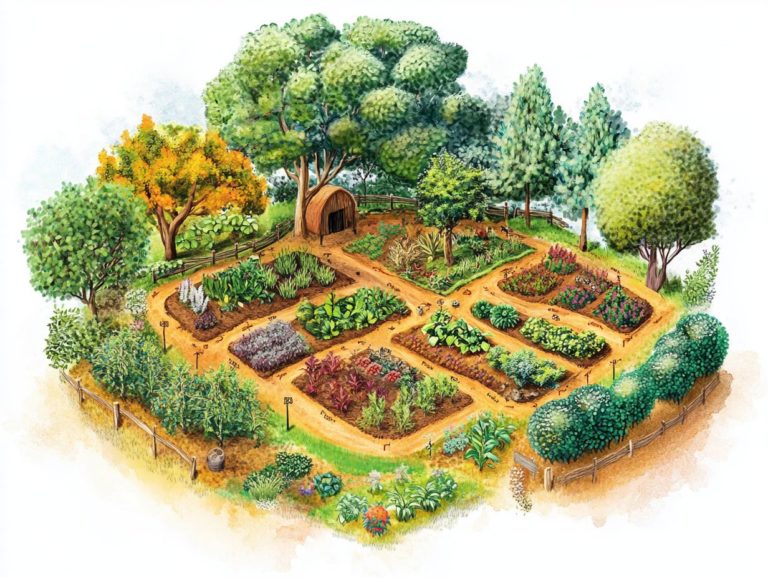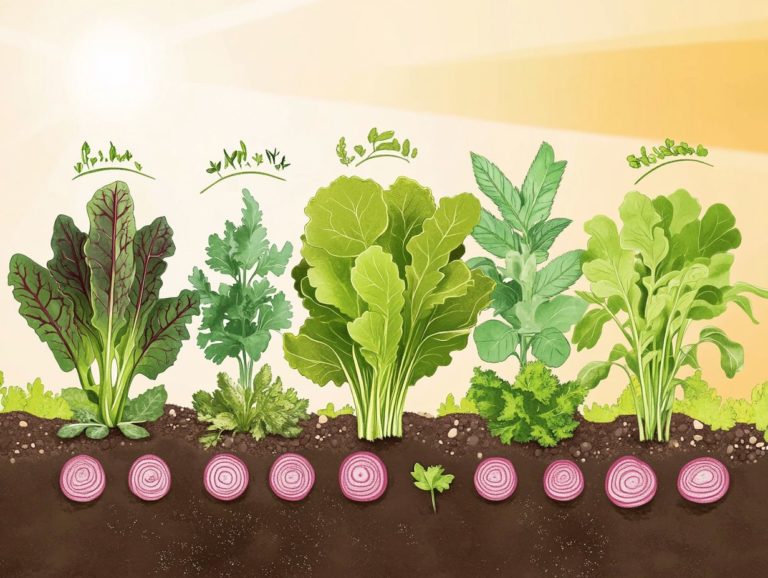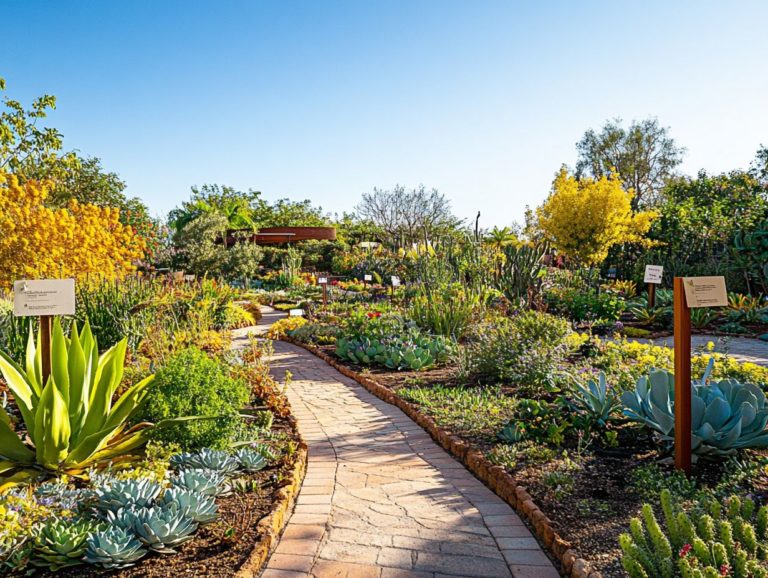“Choosing Plants for Climate Resilience”
In a world increasingly shaped by climate change, grasping the concept of climate resilience has never been more critical. This understanding ties closely to the principles of sustainable gardening and edible landscaping.
This article delves into what climate resilience truly means and why it holds particular significance in the realm of gardening. It is especially relevant through traditional landscaping techniques that enhance biodiversity, which is the variety of plant and animal life in a particular habitat. When choosing plants, consider key factors such as climate and soil conditions, along with the diverse array of climate-resilient plants available. This includes native species that support local wildlife habitats.
Uncover practical tips for designing your garden to flourish despite environmental challenges. Emphasizing vertical gardening and container gardening can be particularly useful for small spaces. Let s cultivate a sustainable and resilient green space together, integrating both food production and visual interest.
Contents
- Key Takeaways:
- Understanding Climate Resilience
- Factors to Consider When Choosing Plants
- Types of Climate-Resilient Plants
- Designing a Climate-Resilient Garden
- Additional Tips for Ensuring Plant Resilience
- Frequently Asked Questions
- Why is it important to choose plants for climate resilience?
- How can I determine if a plant is climate resilient?
- What are some examples of climate resilient plants?
- How can I incorporate climate resilience into my landscaping?
- What are some other ways to support climate resilience in my garden?
Key Takeaways:
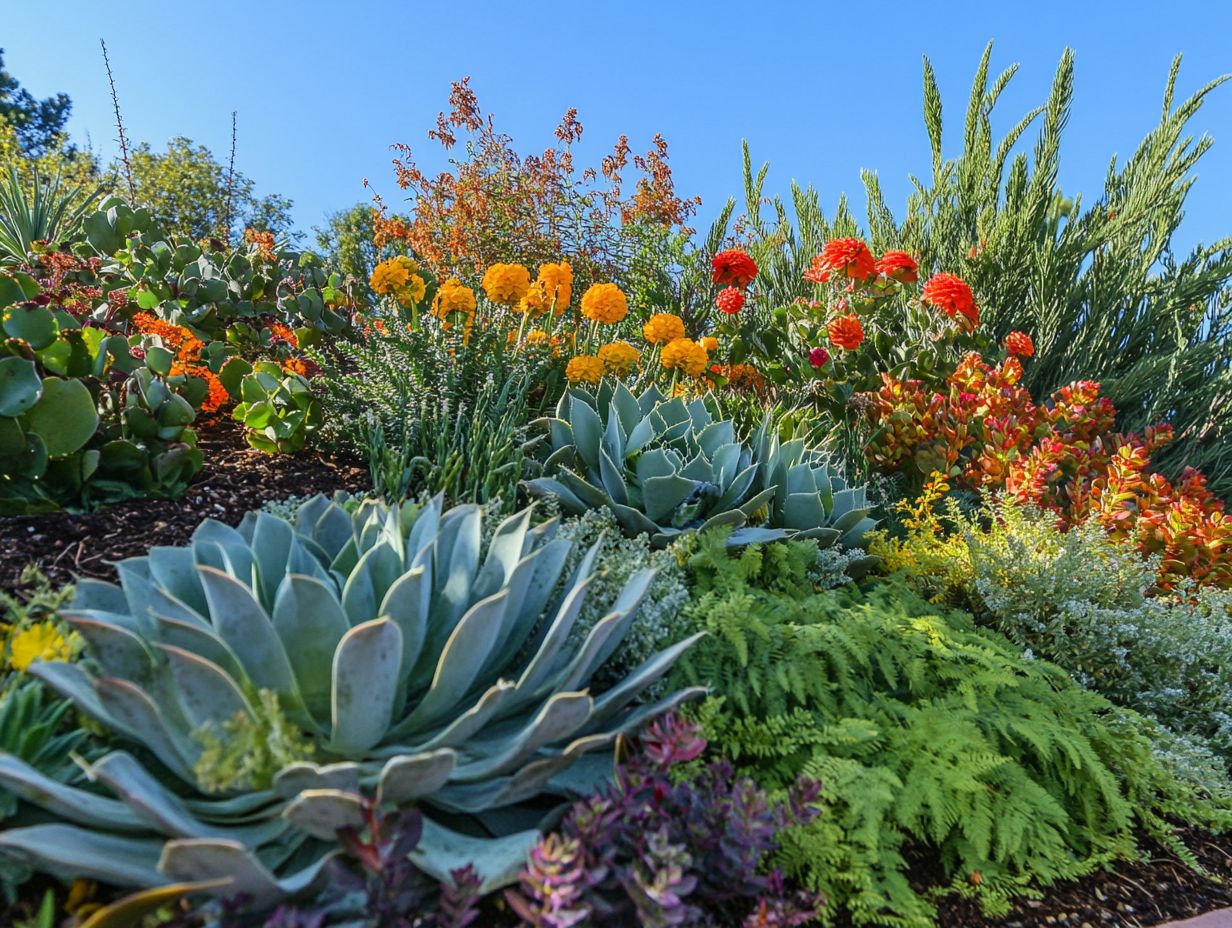
- Understanding climate resilience is crucial for creating a sustainable and thriving garden.
- When choosing plants, consider the climate, soil, and water availability to ensure they can withstand weather patterns.
- Incorporating a variety of drought-resistant, cold-weather resistant, and flood-tolerant plants can make a garden more resilient.
Understanding Climate Resilience
Understanding climate resilience is vital for crafting sustainable landscapes that can adapt to evolving environmental conditions. This is particularly important in urban areas, where biodiversity often takes a hit and the impact of food transportation is felt.
This concept seamlessly weaves together traditional landscaping principles. It also highlights the significance of food production through the incorporation of edible plants, echoing the practices of the Victory Garden movement.
Recognizing the complex ecosystems in your garden can boost productivity and beauty. This approach resonates with the philosophies of ancient civilizations, such as the Babylonians and Egyptians, who understood the value of holistic living in contributing to a sustainable way of life.
Defining Climate Resilience and its Importance
Climate resilience is about your landscape’s ability to withstand and adapt to the ever-changing climate. This ensures biodiversity thrives while also aligning with community goals for sustainable practices.
This essential trait plays a pivotal role in sustainable gardening practices. It empowers you to create environments that flourish even under climate challenges, supporting a rich variety of plants and wildlife, including pollinators and beneficial insects.
For example, organizations like the Permaculture Institute champion techniques such as native plant gardening. This not only enriches local ecosystems but also minimizes the need for water and chemicals while promoting organic food production.
When urban green spaces are thoughtfully designed with climate resilience in mind, they can cultivate community engagement. They also provide crucial habitats for wildlife while enhancing outdoor space and promoting ecological impact.
By embracing these principles, you can bolster your community’s resilience and foster a more harmonious relationship with nature. This ensures the integration of gardening techniques that support fresh produce availability.
Factors to Consider When Choosing Plants
When selecting plants for a climate-resilient garden, it s essential to consider several key factors. Think about the culinary uses of various plants and their visual hierarchy within the garden.
Consider the climate and weather patterns in your area, the health of your soil, and the availability of water. Also, evaluate the potential for raised beds and garden maintenance practices. Each of these elements plays a significant role in determining the success of both your edible and ornamental plants, contributing to a vibrant garden design.
Start planning your climate-resilient garden today and make a positive impact!
Climate and Weather Patterns
Understanding local climate is vital for urban gardening success. It dictates the types of fruit and vegetable plants that can flourish. These factors determine which edible and ornamental plants can truly thrive in your environment, particularly in gardens designed for both beauty and usefulness.
The optimal temperature ranges and consistent rainfall are crucial for plant health and productivity, especially regarding food production. For instance, in regions with warm, moist conditions, leafy greens like spinach and kale flourish in cooler temperatures, ideal for culinary gardening. Conversely, during prolonged droughts, focus on drought-resistant varieties such as succulents or Mediterranean herbs like rosemary and thyme, which offer excellent culinary uses.
Seasonal changes dictate your planting schedule. Spring presents the perfect opportunity for sowing tender annuals, while autumn is ideal for perennials that need to establish their roots before frost sets in, ensuring they provide visual interest throughout the year. By grasping these nuances, you can select plant species that enhance the aesthetics of your garden while boosting your food production outcomes and contributing to food security.
Soil and Water Availability
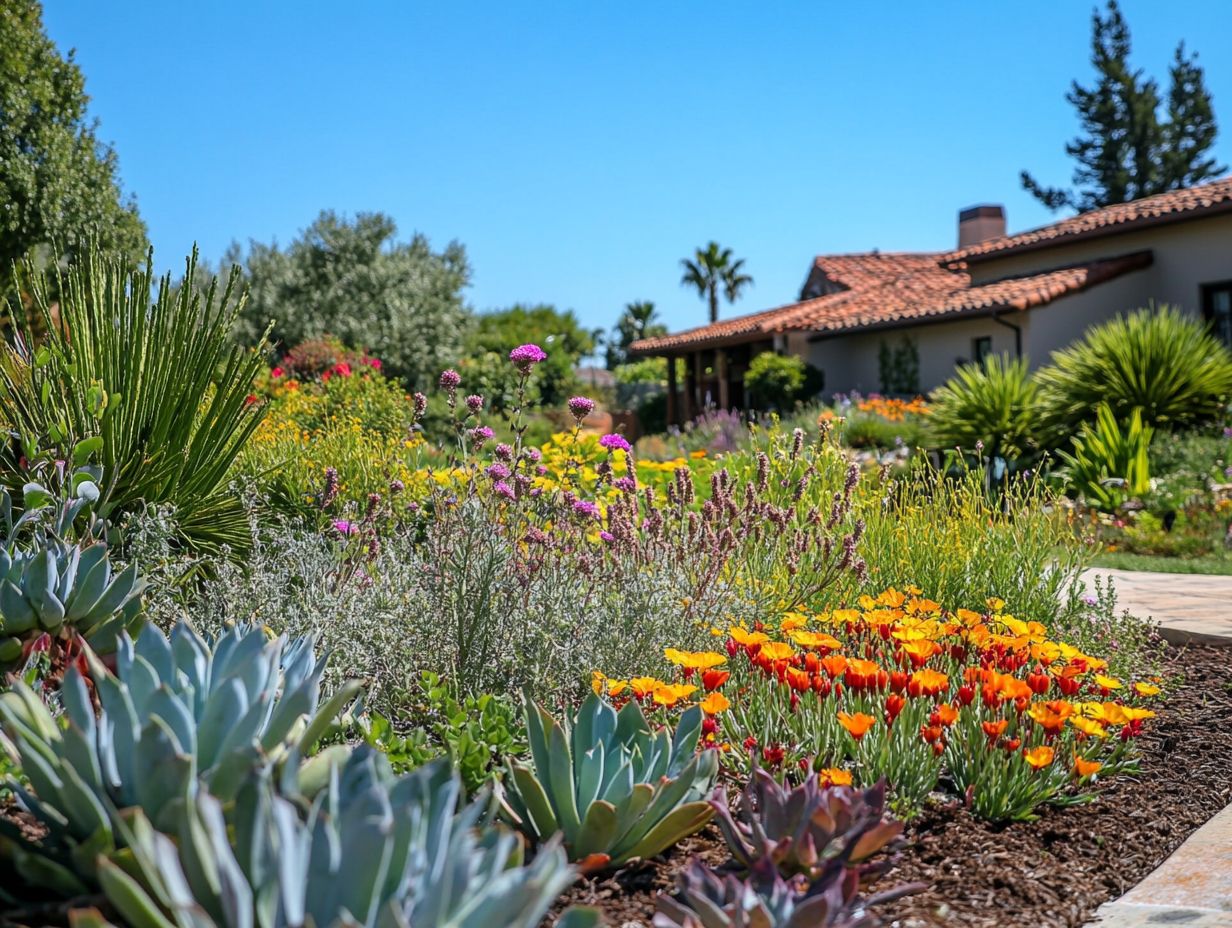
Don t overlook soil health it’s the key to thriving plants! Healthy soil is the foundation for strong plant growth, influencing nutrient levels, microbial activity, and moisture retention. These factors are crucial for achieving organic food and sustainable yields. Equally essential is the careful management of water resources, nurturing your plants while minimizing waste through practices like rainwater harvesting.
Incorporate techniques such as:
- Crop rotation
- Cover cropping
- Composting
These practices enhance soil structure and fertility over time, promoting the health of beneficial insects and other organisms. They not only yield organic food but also support ecosystems vital for maintaining healthy ecological systems.
Ultimately, by embracing sustainable gardening methods, you strengthen both the environment and your community, resulting in bountiful harvests of fresh produce and a resilient landscape that supports holistic living.
Types of Climate-Resilient Plants
Incorporating a diverse array of climate-resilient plants into your garden design significantly enhances sustainability. Consider integrating:
- Drought-resistant varieties
- Cold-weather hardy plants
- Flood-tolerant species
- Edible flowers for a culinary gardening approach
This thoughtful selection beautifies your space and contributes to a more resilient ecosystem that can be effectively managed with creative landscapes and appropriate pruning techniques.
Start planning your garden today for better sustainability and productivity!
Drought-Resistant Plants
Drought-resistant plants are vital for sustainability in arid climates. They require less water and thrive in low moisture conditions, enhancing overall climate resilience.
By incorporating these plants into your edible landscaping, you elevate the visual charm of your garden while ensuring it remains productive, even in unpredictable weather. This approach also supports local wildlife habitats.
Varieties like sage, lavender, and certain succulents not only withstand prolonged dry spells but also attract beneficial pollinators, which are essential for preserving biodiversity in your garden. These resilient plants also help with water conservation, making them exceptional choices for sustainable gardening, especially given climate challenges that affect food security.
Utilizing techniques such as mulching and collecting rainwater for your garden will further boost your garden’s water efficiency. These practices enhance sustainable efforts that contribute to community goals.
This approach cultivates a thriving ecosystem that supports both biodiversity and food production, all while reducing dependence on frequent irrigation, which is crucial for urban gardening.
Cold-Weather Resistant Plants
Cold-weather resistant plants are essential for keeping your garden productive and visually appealing during harsh winter conditions. This is particularly true when using raised beds for insulation.
Consider plants like kale, winterberry, and hellebores. They not only survive the chill but also flourish with vibrant colors and nutritional value throughout the colder months, perfect for cooking uses and fresh produce.
For instance, kale can withstand frost, which actually enhances its flavor and allows for a consistent harvest. This makes it a staple in culinary gardening.
To protect these resilient varieties from chilling winds and snow accumulation, proper care techniques such as mulching and layering protective fabrics can make all the difference in maintaining landscape design.
Embracing sustainable practices, like using organic fertilizers and compost, supports soil health, vital for the success of your winter garden and in producing quality organic food.
Start using these strategies today to create landscapes that endure winter and support wildlife habitats, promoting biodiversity and environmental stewardship.
Flood-Tolerant Plants
Flood-tolerant plants are essential for keeping local ecosystems healthy in areas susceptible to heavy rainfall. They play a vital role in climate resilience by preventing erosion and fostering local biodiversity.
Consider incorporating hardy species like Swamp Milkweed, Blue Flag Iris, and River Birch into your garden. These plants can thrive in saturated soils while also providing crucial habitats for a variety of wildlife, enhancing your landscaping’s ecological impact.
By integrating them into your landscape design, you can create functional gardens that effectively filter stormwater runoff, mitigate flooding, and enhance soil health. This ensures a sustainable way of managing water resources.
Strategically positioning these plants in rain gardens or along slopes captures excess water and helps create creative landscapes. Their vibrant blooms and lush foliage elevate the aesthetic of your outdoor spaces, enhancing the overall visual hierarchy of your garden.
Embrace flood-tolerant plants to build a resilient garden that thrives in any weather while contributing to your community s sustainability efforts, supporting the overarching goals of food security and community resilience.
Designing a Climate-Resilient Garden
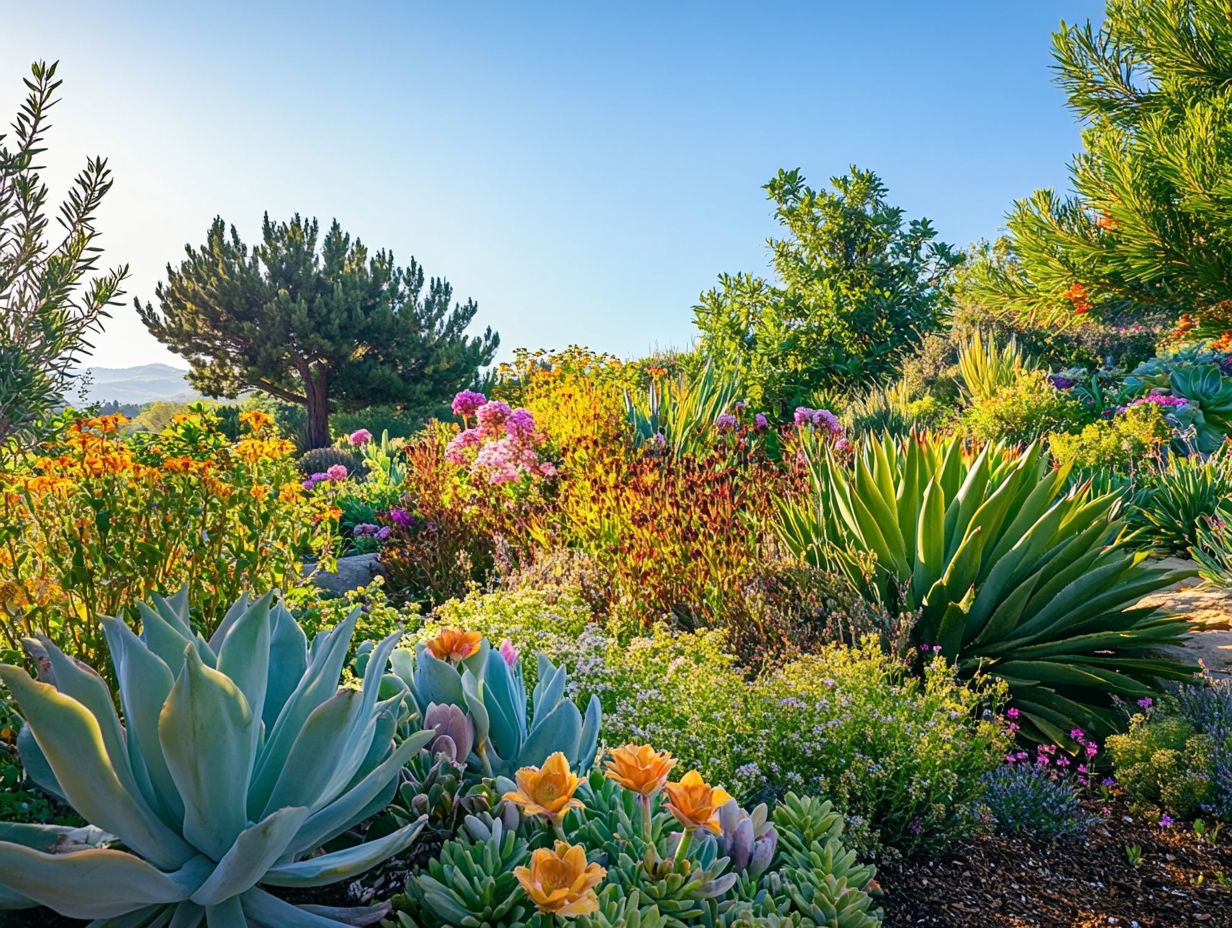
Get started on your climate-resilient garden today! Your plants will thank you. Designing a climate-resilient garden means you should plan where to place your plants, including using companion planting techniques that enhance biodiversity.
Consider using methods like companion planting, where you select plants that support each other s growth and can be used in cooking.
This thoughtful approach will create a thriving ecosystem that can withstand the challenges of a changing climate.
Strategic Plant Placement and Maintenance
Smart plant placement and care are key to a healthy garden. This approach promotes soil health and optimizes sunlight and water usage.
By grouping plants with similar water and light needs, you can minimize competition and ensure that each species flourishes.
Incorporating native plants is another smart move; these varieties enhance biodiversity and boost resilience, as they re perfectly adapted to local conditions.
Implement companion planting. Certain combinations can deter pests, enhance nutrient uptake, and create a balanced ecosystem.
Regular soil testing and adding organic matter like compost will support a rich microbial community vital for nutrient cycling and overall soil health.
This leads to a more sustainable gardening approach that benefits both you and the environment.
Additional Tips for Ensuring Plant Resilience
To ensure your plants are strong, follow these key strategies. Start with proper plant selection, choosing varieties that thrive in your specific environment.
Using natural pest control methods will further enhance your garden’s health while adopting effective gardening techniques tailored to the unique needs of your plants will set you on the path to success.
Proper Plant Selection and Care
Proper plant selection and care are essential for cultivating climate resilience in your garden, ensuring that you integrate edible plants capable of thriving in your unique environmental conditions.
By understanding your local climate such as temperature fluctuations, rainfall averages, and seasonal shifts you can make informed choices about which plants to introduce to your garden.
It s vital to check the type of soil be it sandy, clay, or loamy since this directly influences drainage and nutrient availability.
Choosing local plants helps them thrive and supports biodiversity. Employing strategies like mulching to retain moisture and using organic fertilizers to enrich nutrients will significantly bolster their growth.
With the right techniques, you can cultivate a vibrant, productive garden that stands resilient against climatic challenges.
Using Natural Pest Control Methods
Natural pest control keeps your garden healthy. By attracting beneficial insects, you can grow more organic food while minimizing chemical usage.
Embrace techniques such as attracting predatory insects, utilizing companion planting, and applying organic repellents to create a thriving environment where pests are managed effectively without resorting to harmful chemicals.
These methods not only protect your crops but also positively influence soil health and biodiversity.
By integrating these practices into your sustainable gardening routine, you enhance overall ecological balance, contributing to a flourishing ecosystem that nurtures not just your garden but also local wildlife.
Focusing on the interconnectedness of all living things, these strategies become vital components of your responsible gardening approach.
Frequently Asked Questions
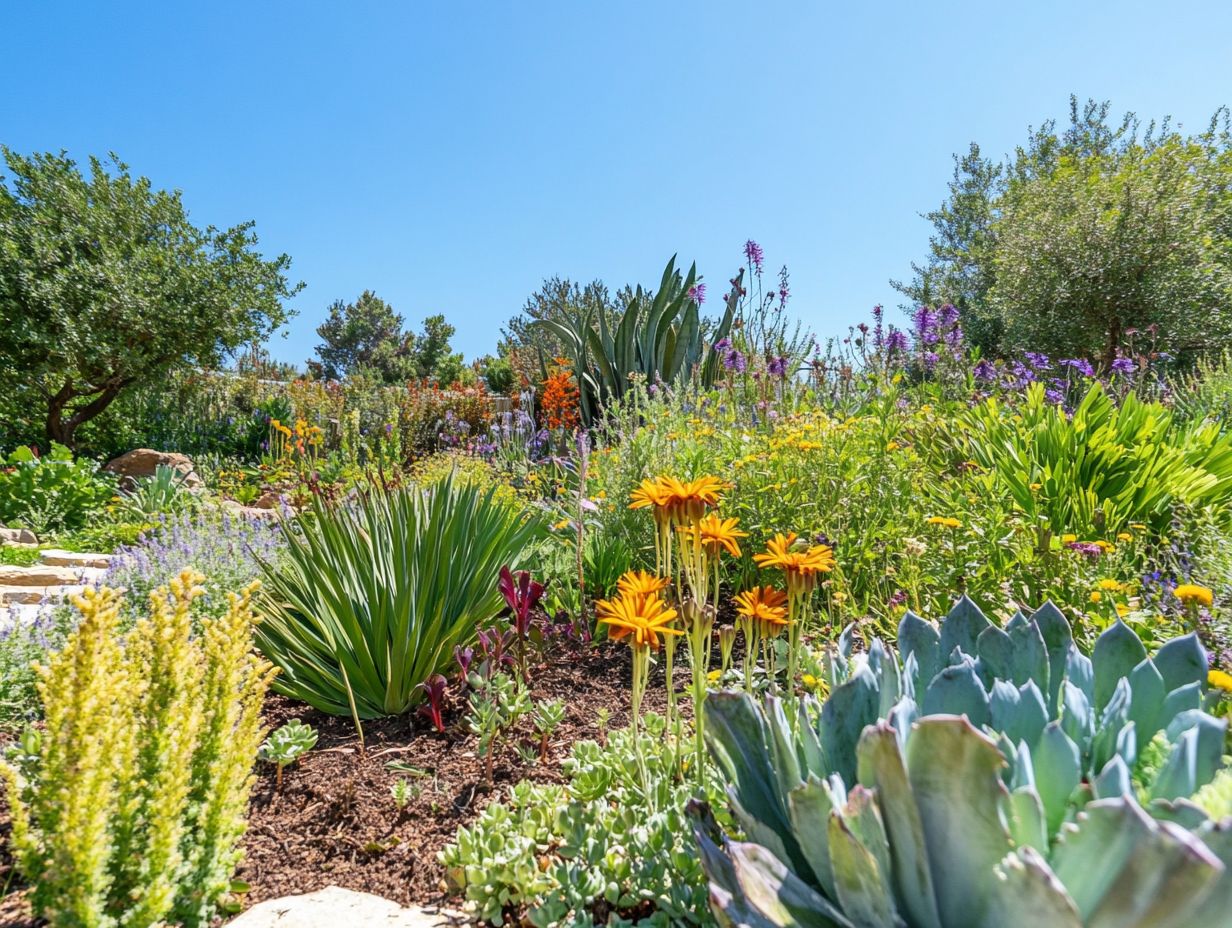
What does it mean to choose plants for climate resilience?
Want to know how to choose the right plants for your garden? Choosing plants for climate resilience means selecting plant species that can withstand and adapt to changing climatic conditions without significant negative impacts on their growth or survival.
Begin your journey to a climate-resilient garden today! Join the movement towards sustainable gardening.
Why is it important to choose plants for climate resilience?
Choosing plants that thrive in changing climates is crucial for our gardens’ health. This ensures long-term sustainability for our landscapes.
How can I determine if a plant is climate resilient?
To determine if a plant is climate resilient, check its native growing area and how well it survives heat and drought. Consulting with local gardening experts or using online resources can also help you make informed choices.
What are some examples of climate resilient plants?
Discover amazing plants that thrive even when conditions change! Some examples include native species, drought-tolerant plants, and those with deep root systems that access water during dry periods.
Succulents, native grasses, and resilient shrubs and trees are great options for a climate-friendly garden.
How can I incorporate climate resilience into my landscaping?
Incorporating a mix of climate resilient plants can create a sustainable garden. Use a variety of plant types suited to your climate and group them by their water and nutrient needs for efficient irrigation.
What are some other ways to support climate resilience in my garden?
Choose climate-resilient plants and apply other practices to support a resilient garden. Use mulch to retain moisture, reduce lawn areas by replacing them with drought-tolerant plants, and consider rain gardens for water conservation.
Regularly monitor and maintain your garden to ensure its resilience over time. What plants will you choose for your climate-friendly garden?

